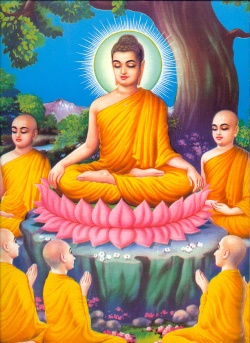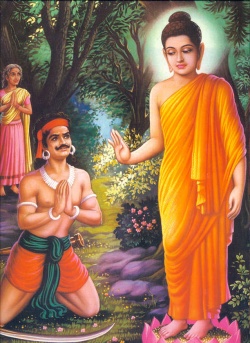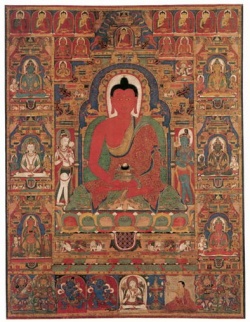Right Mindfulness & Concentration
Visakha: Now what is Concentration, what qualities are its themes, what qualities are its requisites, and what is its development?
Sister Dhammadinna: Singleness of mind is Concentration; the four frames of reference [ = the objects of right mindfulness] are its themes; the Four Right Exertions [ = right effort] are its requisites; and any cultivation, development, and pursuit of these qualities is its development.
— M 44
Mindfulness of in-and-out breathing, when developed and pursued, brings the four frames of reference to their culmination. The four frames of reference, when developed and pursued, bring the seven factors for Awakening to their culmination. The seven factors for Awakening, when developed and pursued, bring clear knowing and release to their culmination.
Now how is Mindfulness of in-and-out breathing developed and pursuedso as to bring the four frames of reference to their culmination?
There is the case where a Monk, having gone to the wilderness, to the shade of a tree, or to an empty building, sits down folding his legs crosswise, holding his Body erect, and setting Mindfulness to the fore. Always mindful, he breathes in; mindful he breathes out.
"(1) Breathing in long, he discerns, 'I am breathing in long'; or breathing out long, he discerns, 'I am breathing out long.' (2) Or breathing in short, he discerns, 'I am breathing in short'; or breathing out short, he discerns, 'I am breathing out short.' (3) He trains himself, 'I will breathe in sensitive to the entire Body.' He trains himself, 'I will breathe out sensitive to the entire Body.' (4) He trains himself, 'I will breathe in calming bodily fabrication.' He trains himself, 'I will breathe out calming bodily fabrication.'
(5) He trains himself to breathe in sensitive to rapture, and to breathe out sensitive to rapture. (6) He trains himself to breathe in sensitive to pleasure, and to breathe out sensitive to pleasure. (7) He trains himself to breathe in sensitive to mental fabrication, and to breathe out sensitive to mental fabrication. (8) He trains himself to breathe in calming mental fabrication, and to breathe out calming mental fabrication.
(9) He trains himself to breathe in sensitive to the mind, and to breathe out sensitive to the mind. (10) He trains himself to breathe in satisfying the mind, and to breathe out satisfying the mind. (11) He trains himself to breathe in steadying the mind, and to breathe out steadying the mind. (12) He trains himself to breathe in releasing the mind, and to breathe out releasing the mind.
(13) He trains himself to breathe in focusing on inconstancy, and to breathe out focusing on inconstancy. (14) He trains himself to breathe in focusing on dispassion (literally, fading), and to breathe out focusing on dispassion. (15) He trains himself to breathe in focusing on cessation, and to breathe out focusing on cessation. (16) He trains himself to breathe in focusing on relinquishment, and to breathe out focusing on relinquishment.
Now, on whatever occasion a Monk breathing in long discerns that he is breathing in long; or breathing out long, discerns that he is breathing out long; or breathing in short, discerns that he is breathing in short; or breathing out short, discerns that he is breathing out short; trains himself to breathe in... and... out sensitive to the entire Body; trains himself to breathe in... and... out calming bodily fabrication: On that occasion the Monk remains focused on the Body in and of itself — ardent, alert, and mindful — putting aside Greed and distress with reference to the World. I tell you, monks, that this — the in-and-out Breath — is classed as a Body among bodies, which is why the Monk on that occasion remains focused on the Body in and of itself — ardent, alert, and mindful — putting aside Greed and distress with reference to the World.
On whatever occasion a Monk trains himself to breathe in... and... out sensitive to rapture; trains himself to breathe in... and... out sensitive to pleasure; trains himself to breathe in... and... out sensitive to mental fabrication; trains himself to breathe in... and... out calming mental fabrication: On that occasion the Monk remains focused on feelings in and of themselves — ardent, alert, and mindful — putting aside Greed and distress with reference to the World. I tell you, monks, that this — close attention to in-and-out breaths — is classed as a feeling among feelings, which is why the Monk on that occasion remains focused on feelings in and of themselves — ardent, alert, and mindful — putting aside Greed and distress with reference to the World.
On whatever occasion a Monk trains himself to breathe in... and... out sensitive to the mind; trains himself to breathe in... and... out satisfying the mind; trains himself to breathe in... and... out steadying the mind; trains himself to breathe in... and... out releasing the mind: On that occasion the Monk remains focused on the mind in and of itself — ardent, alert, and mindful — putting aside Greed and distress with reference to the World. I don't say that there is Mindfulness of in-and-out breathing in one of confused Mindfulness and no alertness, which is why the Monk on that occasion remains focused on the mind in and of itself — ardent, alert, and mindful — putting aside Greed and distress with reference to the World.
On whatever occasion a Monk trains himself to breathe in... and... out focusing on inconstancy; trains himself to breathe in... and... out focusing on dispassion; trains himself to breathe in... and... out focusing on cessation; trains himself to breathe in... and... out focusing on relinquishment: On that occasion the Monk remains focused on mental qualities in and of themselves — ardent, alert, and mindful — putting aside Greed and distress with reference to the World. He who sees clearly with discernment the abandoning of Greed and distress is one who oversees with Equanimity, which is why the Monk on that occasion remains focused on mental qualities in and of themselves — ardent, alert, and mindful — putting aside Greed and distress with reference to the World.
This is how Mindfulness of in-and-out breathing is developed and pursued so as to bring the four frames of reference to their culmination.
And how are the four frames of reference developed and pursued so as to bring the seven factors for Awakening to their culmination?
(1) On whatever occasion the Monk remains focused on the Body in and of itself — ardent, alert, and mindful — putting aside Greed and distress with reference to the World, on that occasion his Mindfulness is steady and without lapse. When his Mindfulness is steady and without lapse, then Mindfulness as a factor for Awakening becomes aroused. He develops it, and for him it goes to the culmination of its development.
(2) Remaining mindful in this way, he examines, analyzes, and comes to a comprehension of that quality with discernment. When he remains mindful in this way, examining, analyzing, and coming to a comprehension of that quality with discernment, then analysis of qualities as a factor for Awakening becomes aroused. He develops it, and for him it goes to the culmination of its development.
(3) In one who examines, analyzes, and comes to a comprehension of that quality with discernment, unflagging persistence is aroused. When unflagging persistence is aroused in one who examines, analyzes, and comes to a comprehension of that quality with discernment, then persistence as a factor for Awakening becomes aroused. He develops it, and for him it goes to the culmination of its development.
(4) In one whose persistence is aroused, a rapture not-of-the-flesh arises. When a rapture not-of-the-flesh arises in one whose persistence is aroused, then rapture as a factor for Awakening becomes aroused. He develops it, and for him it goes to the culmination of its development.
(5) For one who is enraptured, the Body grows calm and the mind grows calm. When the Body and mind of an enraptured Monk grow calm, then serenity as a factor for Awakening becomes aroused. He develops it, and for him it goes to the culmination of its development.
(6) For one who is at ease — his Body calmed — the mind becomes concentrated. When the mind of one who is at ease — his Body calmed — becomes concentrated, then Concentration as a factor for Awakening becomes aroused. He develops it, and for him it goes to the culmination of its development.
(7) He oversees the mind thus concentrated with Equanimity. When he oversees the mind thus concentrated with Equanimity, Equanimity as a factor for Awakening becomes aroused. He develops it, and for him it goes to the culmination of its development.
(Similarly with the other three frames of reference: feelings, mind, and mental qualities.)
This is how the four frames of reference are developed and pursued so as to bring the seven factors for Awakening to their culmination.
And how are the seven factors for Awakening developed and pursued so as to bring clear knowing and release to their culmination? There is the case where a Monk develops Mindfulness as a factor for Awakening dependent on seclusion... dispassion... cessation, resulting in relinquishment. He develops analysis of qualities as a factor for Awakening...persistence as a factor for Awakening...rapture as a factor for Awakening...serenity as a factor for Awakening... Concentration as a factor for Awakening... Equanimity as a factor for Awakening dependent on seclusion... dispassion... cessation, resulting in relinquishment.
This is how the seven factors for Awakening are developed and pursued so as to bring clear knowing and release to their culmination.
— M 118
[On attaining the fourth level of jhana] there remains only Equanimity: pure and bright, pliant, malleable and luminous. Just as if a skilled goldsmith or goldsmith's apprentice were to prepare a furnace, heat up a crucible, and, taking gold with a pair of tongs, place it in the crucible. He would blow on it periodically, sprinkle water on it periodically, examine it periodically, so that the gold would become refined, well-refined, thoroughly refined, flawless, free from dross, pliant, malleable and luminous. Then whatever sort of ornament he had in mind — whether a belt, an earring, a necklace, or a gold chain — it would serve his purpose. In the same way, there remains only Equanimity: pure and bright, pliant, malleable, and luminous. He (the meditator) discerns that 'If I were to direct Equanimity as pure and bright as this toward the dimension of the infinitude of space, I would develop the mind along those lines, and thus this Equanimity of mine — thus supported, thus sustained — would last for a long time. (Similarly with the dimensions of the infinitude of Consciousness, nothingness, and neither Perception nor non-Perception.)'
He discerns that 'If I were to direct Equanimity as pure and bright as this toward the dimension of the infinitude of space and to develop the mind along those lines, that would be fabricated. (Similarly with the dimensions of the infinitude of Consciousness, nothingness, and neither Perception nor non-Perception.)' He neither fabricates nor wills for the sake of becoming or un-becoming. This being the case, he is not sustained by anything in the World (does not cling to anything in the World). Unsustained, he is not agitated. Unagitated, he is totally unbound right within. He discerns that 'Birth is ended, the holy Life fulfilled, the task done. There is nothing further for this World.'



